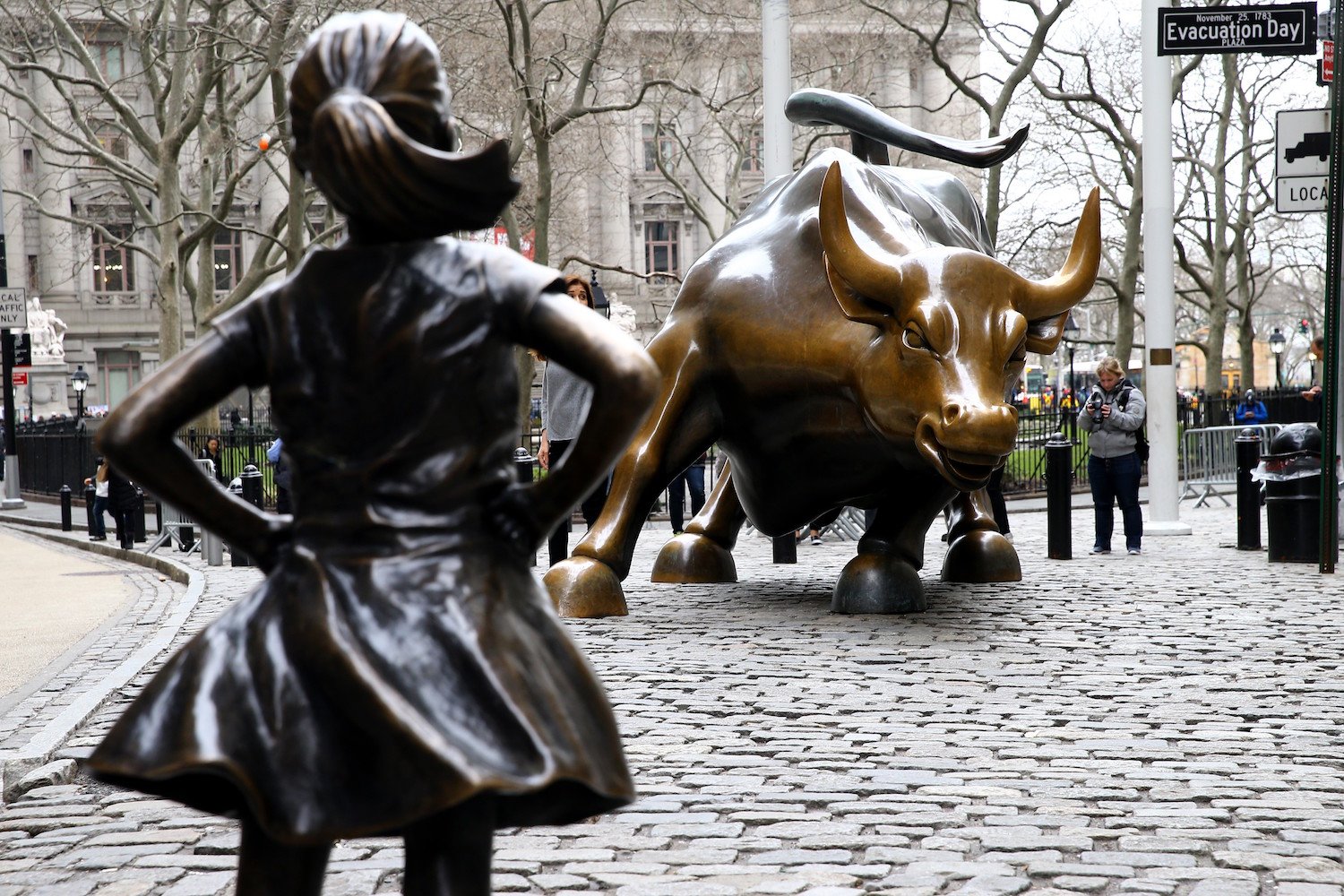
After spending over a year facing down Charging Bull, the diminutive Fearless Girl statue—either a calculating corporate marketing stunt or an inspiring message for women’s equality, depending on who you talk to—is moving to a new home a few blocks away, strategically located outside the New York Stock Exchange. News that the sculpture was getting a permanent home first broke in February.
“We are proud to be home to the Fearless Girl. She is a powerful symbol of the need for change at the highest levels of corporate America—and she will become a durable part of our city’s civic life,” said Mayor Bill de Blasio in a statement. “This move to a new location will improve access for visitors and ensure that her message and impact continues to be heard.”
“The newest member of the New York Stock Exchange community is just over one year old, but stands as a timeless symbol of the continuing journey toward greater equality and inclusion,” wrote the Stock Exchange. “We eagerly await the arrival of Fearless Girl to her fitting new home, standing her ground and training her unblinking eyes on our engine of progress and free enterprise,” added NYSE president Thomas Farley.
NYSE welcomes Fearless Girl pic.twitter.com/8QmNVLeYfM
— Frank Chaparro (@fintechfrank) April 19, 2018
Originally installed on March 8, 2017, Fearless Girl, designed by artist Kristen Visbal, was planned as a week-long installation, but its unveiling on International Women’s Day went viral, and her run was soon extended through 2018.
Largely overlooked in the heady moment celebrating women’s empowerment was the fact Arturo Di Modica originally created Charging Bull as a guerrilla artwork. The massive bronze statue, meant as a symbol of the resiliency of the American people in the face of an economic downturn, was impounded by the city before getting Mayor Ed Koch’s blessing and a permanent home on Bowling Green, where it was unveiled on December 20, 1989.
Fearless Girl, on the other hand, is very much a product of the male-dominated corporate world it claims to critique. The statue is the brainchild of financial firm State Street Global Advisors and advertising firm McCann New York. It was originally accompanied by a plaque that quietly advertised State Street’s Gender Diversity Index SHE, an exchange-traded fund featuring women-led companies.
Fearless Girl’s critics were quick to point that women hold just 18 percent of leadership positions at State Street. And it was revealed that State Street’s parent company, State Street Corporation, paid $5 million to settle a lawsuit brought by women and black employees who claimed to be underpaid.
For his part, Di Modica blasted Fearless Girl for co-opting his work as part of an advertisement, claiming copyright infringement.
Kristen Visbal’s The Fearless Girl statue on Wall Street. Courtesy of State Street/photographer Federica Valabrega.
His leading ally, Bowling Green Association chairman Arthur Piccolo, has led an impassioned campaign against Fearless Girl, accusing De Blasio of all sorts of improprieties in its installation and continued existence. He launched an email campaign calling to have Fearless Girl moved to “where she belongs where she [c]an do REAL good, standing in front of the New York Stock Exchange.”
“I am and so many others are happy Mayor de Blasio & State Street Global Advisors finally accepted my recommendation first made more than a year ago,” he wrote in a new email. “As for Fearless Girl, why wait until end of this year to move her to her rightful home? Move her NOW… Time to let Charging Bull be Charging Bull and Fearless Girl be Fearless Girl.”
But while Piccolo and Di Modica appear to be getting what they want for now, the city’s press release notes that it “is also looking at a similar move to the vicinity of the stock exchange for the Charging Bull statue.”
Arthur Piccolo created this rendering of The Fearless Girl facing off with the New York Stock Exchange. Courtesy of Arthur Piccolo.
“I’d love it if she could stare down the Charging Bull for the rest of time,” said Manhattan Borough President Gale A. Brewer, “but even if she can’t, I’m glad she will stay in the neighborhood and remind those who pass by the Stock Exchange that it’s past time for companies to put more women in boardrooms and in charge.”
Ultimately, it wasn’t Di Modica’s complaints of copyright violation that led the city to relocate Fearless Girl. The combined popularity of the two statues attracted huge numbers of tourists, which, when combined with car traffic, became a potential public safety hazard.
Fearless Girl‘s new home is easily accessible by foot and largely restricted to car traffic. She will move there by year’s end. Should Charging Bull ever join her, it would be a return to the spot where Di Modica first installed his sculpture, under cover of night, so many years ago.